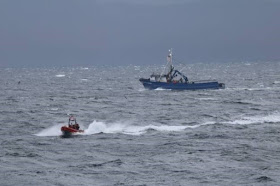Adm. Karl Schultz, Coast Guard commandant, announced Nov. 12, in New York City flanked by New York City Mayor Bill de Blasio, NYPD Commissioner James O’Neill and FDNY Chief of Department John Sudnik, that two new cutters will be named in honor of Port Security Specialist 2nd Class Vincent Danz and Machinery Technician 1st Class Jeffrey Palazzo.
Palazzo served as a Coast Guard Reservist and FDNY firefighter at Rescue 5 in Staten Island. He perished while assisting others at the scene of the 9/11 attacks. Danz served as a Coast Guard Reservist, as well as an NYPD officer at the Emergency Services Unit in the Bronx. He was providing aid to victims on 9/11 when he perished during the World Trade Center collapse.
U.S. Coast Guard photo by Petty Officer 3rd Class John Hightower.
NEW YORK — The Coast Guard announced yesterday that two of its new Sentinel-Class Fast Response Cutters (FRCs) will be named in honor of two extraordinary public servants who served in the Coast Guard and also served in the New York City Fire Department and New York City Police Department, respectively, with both losing their lives responding on 9/11.
Adm. Karl Schultz, Coast Guard commandant, made the announcement in New York City's Battery Park flanked by New York City Mayor Bill de Blasio, NYPD Commissioner James O’Neill and FDNY Chief of Department John Sudnik, that the new cutters will be named in honor of Port Security Specialist 2nd Class Vincent Danz and Machinery Technician 1st Class Jeffrey Palazzo.
Palazzo served as a Coast Guard Reservist and FDNY firefighter at Rescue 5 in Staten Island. He perished while assisting others at the scene of the 9/11 attacks. Danz served as a Coast Guard Reservist, as well as an NYPD officer at the Emergency Services Unit in the Bronx. He was providing aid to victims on 9/11 when he perished during the World Trade Center collapse.
“We are humbled and grateful for the opportunity to honor these brave men whose service and sacrifice spanned three great first-responder organizations,” said Adm. Karl Schultz. “Their broad military and public service to both the Nation and City of New York demonstrated their incredible dedication and character. When the call came, they answered. We are certain that the men and women who serve aboard Coast Guard Cutter Vincent Danz and Coast Guard Cutter Jeffrey Palazzo in the future will proudly carry on their sense of honor, respect, and devotion to duty.”

Adm. Karl Schultz, Coast Guard commandant, is joined on stage by Lisa Palazzo and Angela Danz-Donahue, during a ceremony naming two new cutters after their late husbands.
Adm. Karl Schultz, Coast Guard commandant, announced Nov. 12, in New York City flanked by New York City Mayor Bill de Blasio, NYPD Commissioner James O’Neill and FDNY Chief of Department John Sudnik, that two new cutters will be named in honor of Port Security Specialist 2nd Class Vincent Danz and Machinery Technician 1st Class Jeffrey Palazzo.
Palazzo served as a Coast Guard Reservist and FDNY firefighter at Rescue 5 in Staten Island. He perished while assisting others at the scene of the 9/11 attacks. Danz served as a Coast Guard Reservist, as well as an NYPD officer at the Emergency Services Unit in the Bronx. He was providing aid to victims on 9/11 when he perished during the World Trade Center collapse.
U.S. Coast Guard photo by Petty Officer 3rd Class John Hightower.
“On the day we needed them most, our city’s brave first responders ran toward danger without hesitation,” said Mayor Bill de Blasio. “Officer Vincent Danz and Firefighter Jeffrey Palazzo lived and died in service to our city and our country, and I join the U.S. Coast Guard, NYPD and FDNY in remembering the sacrifices they made to keep us safe. They were heroes, plain and simple, and their spirit will live on through these vessels as they continue to protect our city and nation from harm.”
Firefighter Jeffrey Palazzo bravely served our city and his country, proudly wearing the uniforms of the FDNY and United States Coast Guard,” said Fire Commissioner Daniel A. Nigro. “We will never forget his bravery and the sacrifice he made working to rescue those trapped at the World Trade Center. His legacy will live on through the Sentinel Class Fast Response Cutter that will bear his name and rescue New Yorkers from danger for years to come.”
“Eighteen years ago, New York City Police Officer Vincent Danz was a portrait of courage amid the devastation of the World Trade Center attacks,” said Police Commissioner James P. O’Neill. “His public service on September 11th was exceptional, and yet reflective of the great character of our 36,000-member police force and its dedication to duty. As we think about Vincent’s life, let us always honor – and never forget – his sacrifice for his colleagues, our fellow New Yorkers and our country. To Vincent’s family, we thank you for sharing such a virtuous man with a grateful city. Let this Coast Guard vessel forever be a beacon to anyone in distress and a reminder of our collective mission as first responders to always keep one another safe.”
The new cutters are scheduled for delivery starting in 2023. FRCs are the mainstay of the Coast Guard’s coastal patrol fleet, providing multi-mission capabilities and interagency interoperability. FRCs feature advanced command, control, communications, computers, intelligence, surveillance and reconnaissance equipment; over-the-horizon cutter boat deployment to reach vessels of interest; and improved habitability and sea-keeping. They are replacing the 1980s-era Island-Class 110-foot patrol boats.
-USCG-






























